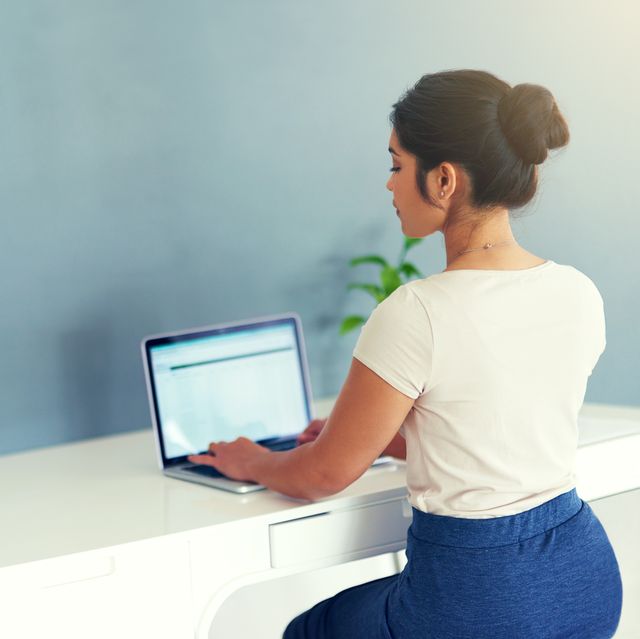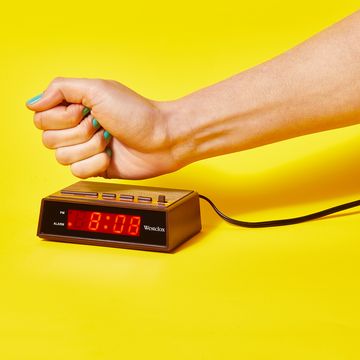For many who work in a traditional office, thinking about their posture while sitting at their desk may be a fleeting thought, as desks and chairs often enable workers to keep their feet flat on the ground and their backs straight. For those who are working from home, however, living room furniture or the soft surfaces in a bedroom aren't nearly as supportive— temporary comfort might soon translate into severe back pain spasms or body aches throughout the work day. This is especially true now during the COVID-19 pandemic, when many have completely transitioned to working from home full time.
Despite what you've heard, keeping backs straight and feet flat on the ground doesn't always mean you're adequately supporting your muscles, says Rahul Shah, MD, FAAOS, a board-certified orthopedic spine and neck surgeon with Premier Orthopaedic Associates in New Jersey. "One of the challenges around posture is that it's very much a personal thing — not everyone is the same," Dr. Shah explains. "But much of the pain we experience from the way we're sitting has to do with muscle fatigue and irritation."
Perfecting your own sitting posture is only half of the battle — the kind of chair you're using during the day may work against you, and Dr. Shah points out that fatigue can also be influenced by whether or not you're getting physical activity at some point. Below, Dr. Shah explains how to choose the best chair for you, why skipping exercising is actually causing you to be sore, and how good posture can help you avoid stiffness and fatigue.
What is the correct sitting posture?
Dr. Shah's most crucial advice for maintaining proper posture while sitting actually has to do with how we stand. Normally, heads and backs are not tilted forward when one walks — this would mean you're hunching over. When you are slumped forward at your desk or in front of a laptop, then, muscles in your back are working extra hard to support them so you don't "tip over" in a sense, Dr. Shah explains.
It makes sense, then, that his key advice is that your head should always be centered over your pelvis. "You want to make sure you're not fatiguing your muscles by keeping your head center to the rear of your pelvis," Dr. Shah says. "Usually, we lean forward to be able to focus on our computers, and this can cause challenges to someone's back that has already been overworking by sitting for hours on hours in a chair."
Here's what else you can do to maintain proper sitting posture, regardless of the chair you're sitting on.
- Keep your legs and knees at a 90 degree angle to your pelvis. While you should adjust your legs if you feel uncomfortable throughout the day, the reason why you may have heard advice to keep your feet flat on the ground is to encourage this proportionally correct relationship to your pelvis as much as possible, Dr. Shah explains. Your knees should be coming out directly in front of you; office chairs can be adjusted to maintain this angle, but some home furniture can't be adjusted to make this comfortable.
- Roll back your shoulders. In line with keeping your head over your pelvis, Dr. Shah advises, you should hold your shoulders high in order to support the spine. Simply leaning your head back won't address poor posture if your shoulders are still slumped and leaning forward over the rest of your body. While you shouldn't keep your shoulders tense, try to remember to position them in line with your ribs rather than slightly forward in front of them, if at all possible.
- Keep your elbows tucked in. You'll notice this occurs naturally if your head is positioned above your pelvis rather than in front of it. While it can be hard to maintain while working on a laptop, keeping your elbows at an extended 90 degree angle can also lead to forearm pain.
- Adjust your position or shift your weight every 20 minutes. Dr. Shah says this is where getting up for a break comes in, because allowing your muscles to move encourages more blood flow, and works against fatigue in the long run. Get up, stretch your legs, stretch your arms, and then reassume your former position.
Where should you sit while working at home?
If you don't have access to a proper office chair and a desk to work on, Dr. Shah says the second best option might depend on your home and your preferences. "Go where you're typically used to sitting for long periods of time. Think about it: Where do we basically spend most of our time actually sitting, not lounging, when we're at home? Usually, that's at the dinner table."
If you're stuck with a couch or a bed, do your best to mimic as many of Dr. Shah's instructions. Don't sit cross legged on your bed, but on its edge; avoid slumping into couch cushions, but sit upright against its armrest. And it's important to move as frequently as possible here, as Dr. Shah says you're more likely to develop muscle fatigue while working on these setups.
How does exercise play into posture?
Even if you follow perfect sitting posture at the office or at home, there's a good chance your muscles can be frequently sore if you aren't getting in any exercise or vigorous movement during the day. Getting your muscles "primed" to withstand the stress (yes, it's a challenge and stress on the body, even if it doesn't feel like one) of sitting in front of a computer for 9 hours a day is crucial.
"A good rule of thumb is to try and block out 20 or 30 minutes of light exercise or continuous movement a day, some kind of physical work to get you at 60 to 70% of your ideal heart rate," Dr. Shah explains. "This'll help you get your muscles primed to withstand the process of sitting."
In the absence of commuting to work, many people who are working at home aren't spending time walking in the mornings — try to mimic that time somehow, if you find yourself experiencing aches and pain despite correcting your posture. Dr. Shah says you shouldn't expect overnight results with these posture changes, but by incorporating movement into your day most people's symptoms will alleviate within six weeks. If it's been more than two months and you've adapted your posture, tried new seating arrangements, and stretched and walked frequently to no avail, it's time to call your primary care provider. "If the back pain or neck pain you're experiencing also travels into your limbs, you may need to get that checked out — posture may not be to blame after all."
Zee Krstic is a content strategy manager for Hearst Magazines, focusing on SEO optimization and other editorial strategies for four brands, including Country Living, House Beautiful, ELLE Decor and VERANDA. He previously served as Health Editor for Good Housekeeping between 2019 and 2023, covering health news, diet and fitness trends as well as executing wellness product reviews in conjunction with the Good Housekeeping Institute. Prior to joining Hearst, Zee fostered a strong background in women's lifestyle media with eight plus years of editorial experience, including as a site-wide editor at Martha Stewart Living after developing a nutrition background as an assistant editor at Cooking Light. Zee produces service-based health coverage, as well as design and travel content, for Hearst brands on a contributor basis; he has written about food and dining for Time, among other publications.













